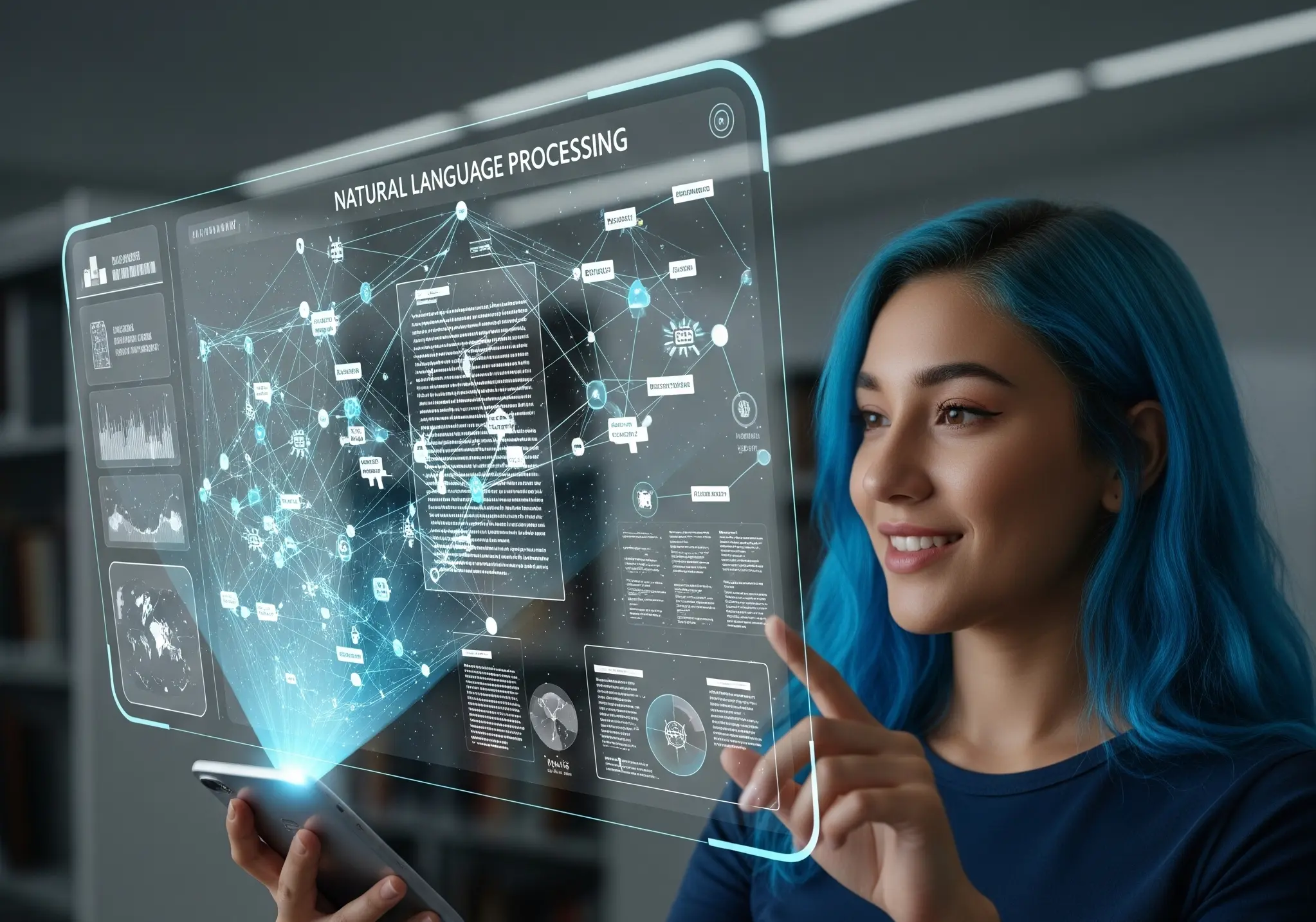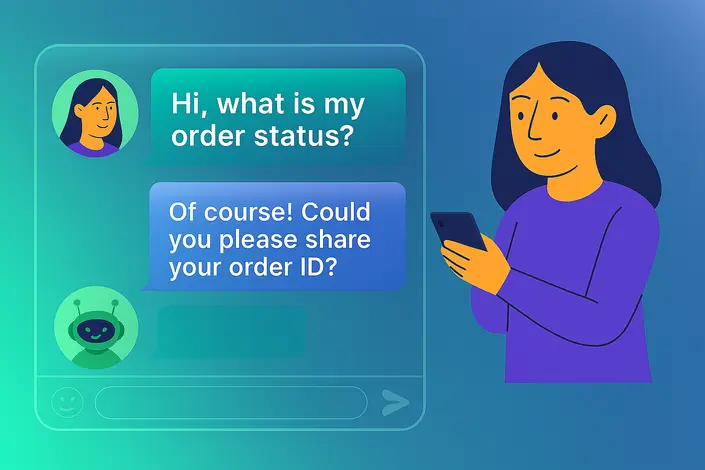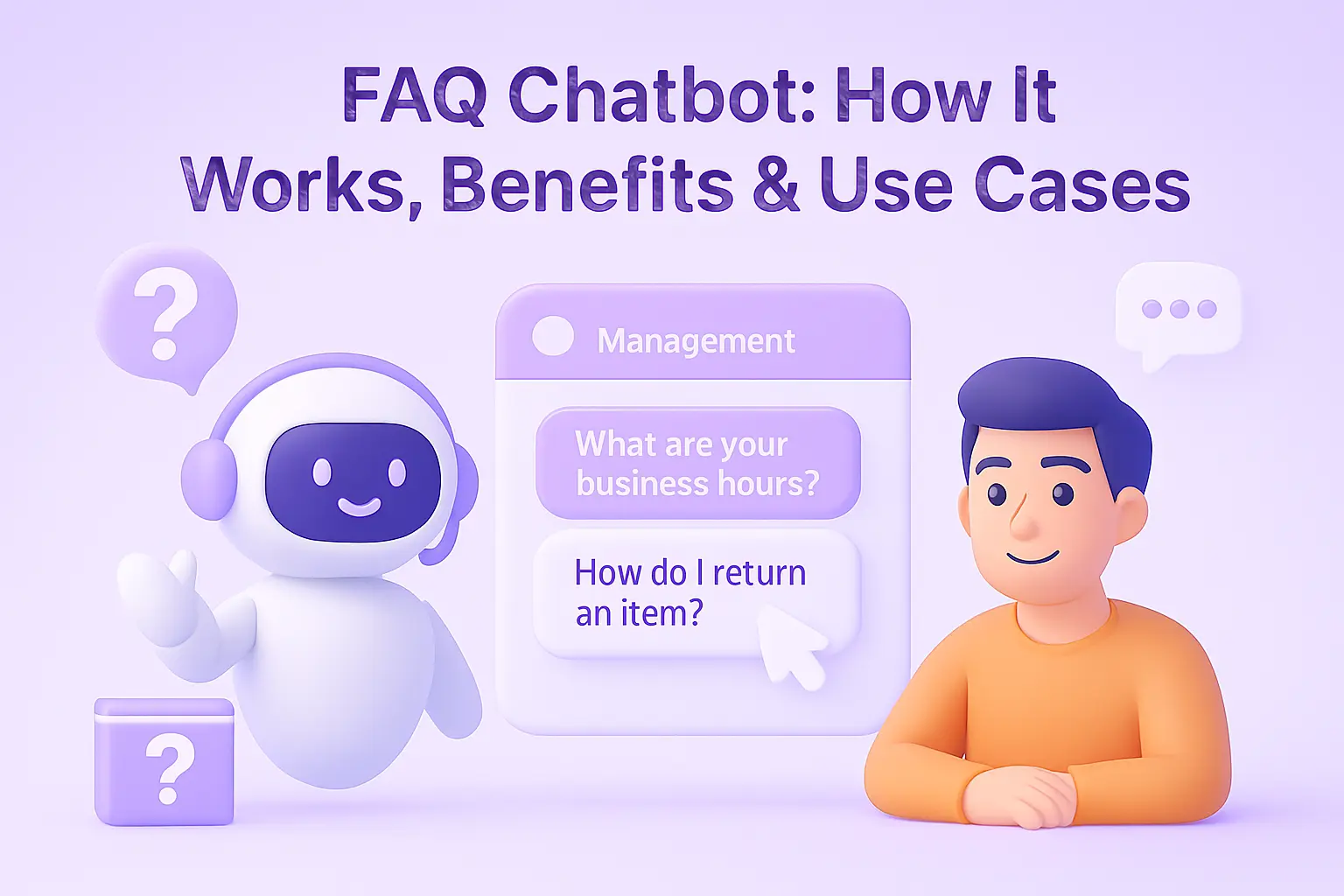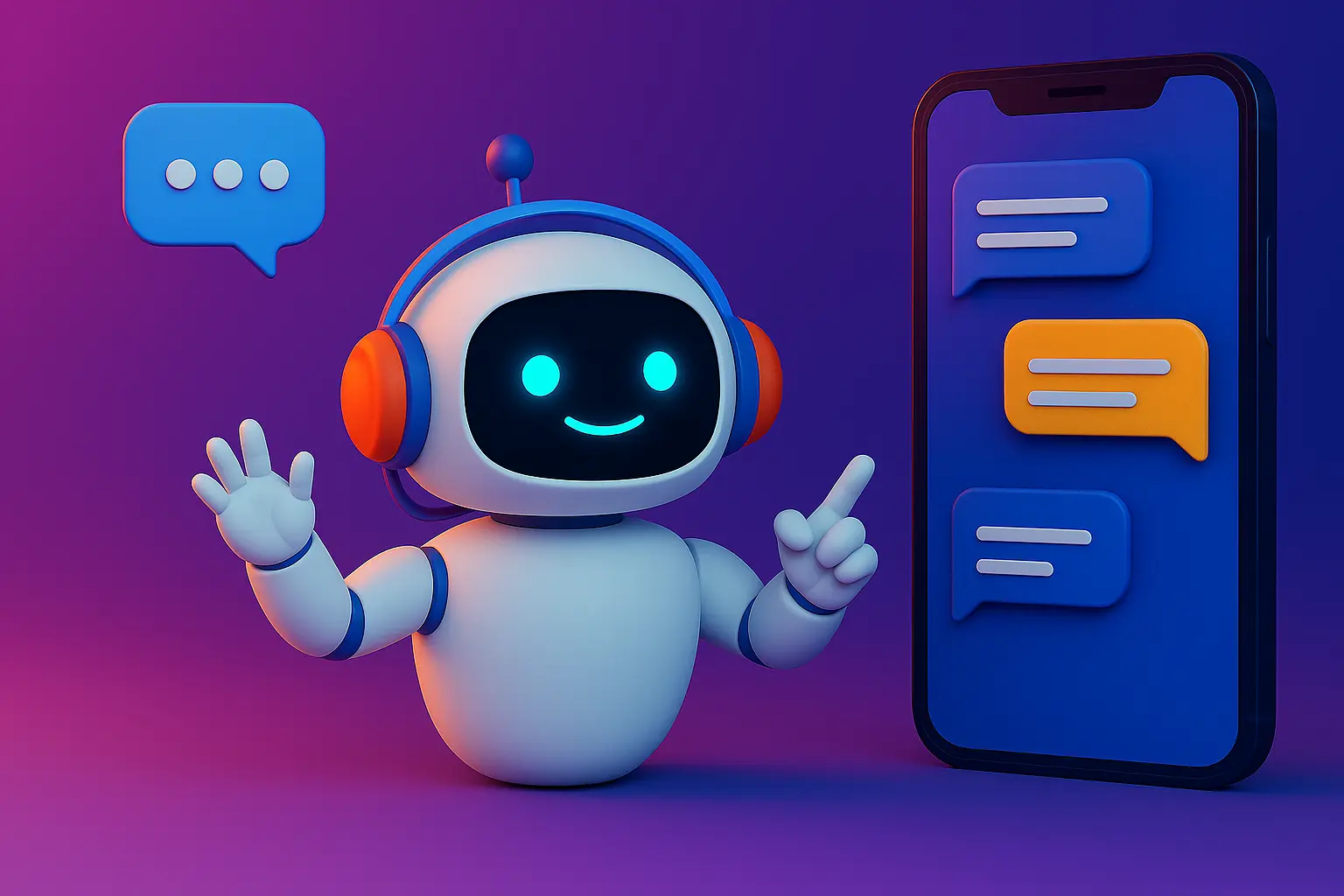What is NLP Chatbot? Benefits, Use Cases & Examples
- January 22, 2024
- 15 mins read
- Listen

Traditional and rule-based chatbots can neither decode the context of conversations nor the intent of the user’s input. This often results in poor interactions. NLP chatbots are different as they are conversational and engaging.
These bots ensure a more human experience when customers visit your website or store. So, you must wonder, how can a chatbot be that advanced? Well, it has to do with the use of NLP – a truly revolutionary technology that has changed the landscape of chatbots.
You should consider using a bot as by 2027, they will become the primary customer support channel for a quarter of organizations across the globe, predicts a Gartner report.
In this blog, we will explore the NLP chatbot, discuss its use cases and benefits, understand how this chatbot is different from traditional ones, and also learn the steps to build one for your business.
Before moving ahead, we will first understand the definition of an NLP chatbot.
What is an NLP Chatbot?
An NLP chatbot ( or a Natural Language Processing Chatbot) is a software program that can understand natural language and respond to human speech. This kind of chatbot can empower people to communicate with computers in a human-like and natural language.
NLP chatbots – also known as AI agents – are advanced with the capability to mimic person-to-person conversations. They employ natural language understanding in combination with generation techniques to converse in a way that feels like humans.
Unlike conventional rule-based bots that are dependent on pre-built responses, NLP chatbots are conversational and can respond by understanding the context. Due to the ability to offer intuitive interaction experiences, such bots are mostly used for customer support tasks across industries.
Why Does Your Business Need an NLP Chatbot?
Global retail spending on chatbots was $12 billion in 2023, and it’s expected to hit $72 billion by 2028. This shows how chatbots are becoming more popular, and investments in them are set to soar further in the coming years. More companies now use NLP chatbots to strengthen customer support and deliver great customer experiences.
There are many reasons why your business needs an NLP chatbot –
Speed up response time
NLP-powered chatbots are intelligent and can easily understand customer queries. They are less likely to give illogical or irrelevant responses, which will help you better engage your audience and keep them happy. What’s more, wait times are minimized and response times are boosted when customer support chatbots understand natural language. What’s more, NLP chatbots can reduce response times by as much as 80% for routine questions.
Improve customer satisfaction
NLP chatbots are advanced and can better engage customers. They are very effective in resolving support queries of any nature. Being powered by NLP helps these bots respond quickly and logically to queries. When responses are quick and coherent, they contribute to customer satisfaction and increase customer loyalty.
Increase sales
Customers don’t face any problems engaging and interacting with NLP-powered chatbots. Responses are quick and meaningful, wait times are low, and queries get resolved instantly. With smart bots working as virtual assistants on the website, customers get the best possible assistance with navigation and other aspects. All this helps your sales grow.
Reduce operational costs
Businesses today can automate a large chunk of their customer support tasks by using an AI and NLP-powered bot. Automation ensures reduced wait times for customers and more efficiency for agents in terms of handling queries per month. In addition, a business can reduce operational costs by automating tasks, as it minimizes dependencies on human agents and improves efficiency as well. After all, chatbots can help businesses save up to 30% in support costs.
Offer multilingual service
Handling customers from different countries and markets once required a heavy investment. Today, all it takes is an NLP chatbot that can help you serve customers in multiple languages. You can serve customers from any part of the world quickly and provide them with solutions in their preferred language. This will help expand your business reach and ensure more profits in the long run.
Personalize customer communication
Customers love personalized interactions as this makes them more loyal to brands. 90% of customers are more likely to do business with a company that offers personalized experiences. You can integrate NLP chatbots with the CRM and let them access key customer data. Based on that, the bot can better understand customers and contexts, helping them provide personalized responses every time they engage with customers.
Key Components of NLP Chatbots
Natural Language Processing (NLP) has a big role in the effectiveness of chatbots. It helps in creating intelligent and conversational interfaces. Similarly, NLP-powered chatbots can understand and respond to user queries in natural language. They can also understand the context of a conversation and recognize the intent behind user messages.
Let’s look at key components of NLP chatbots –
Natural language processing (NLP)
It’s a branch of artificial intelligence that helps machines understand, interpret, and respond to human language logically and meaningfully. The use of NLP is done to improve human-bot communication as it can process and analyze text or speech.
Natural language understanding (NLU)
It’s a subset of NLP that focuses on machine comprehension. It can help machines interpret and extract meaning from human language. Machines that use NLU can comprehend the context, sentiment, and intent of human language and respond accurately.
Natural language generation (NLG)
It’s a subfield of NLP that focuses on using structured data to create human-like speech or text. NLG helps machines generate language that is used by bots. It can also change data into narratives and make them easy to understand for users.
Intent recognition
It’s a key component of NLP chatbots that is used to determine the purpose behind a user’s message. Intent recognition is essential for bots to align their actions with the user’s preferences and needs.
Entity extraction
It’s another key component of an NLP bot that helps identify key data points within the conversations. It ensures better personalization and task execution. Entity extraction is responsible for identifying names, dates, and locations within the interactions.
Dialogue management
Dialogue management is a key component of an NLP chatbot that includes context and session. It helps bots track the flow or state of the conversation. This component is required by bots to guide the conversation logically based on pre-defined rules.
Business logic integration
NLP chatbots need business logic integration as a key component to define how to create, store, modify, and manage data. These logic integrations are a set of algorithms that define rules for data and decisions.
Rapid iteration & training
Chatbots using NLP follow an iterative approach in testing, refining, and improving their performance based on user feedback and interactions. Rapid iteration followed by training ensures continuous evolution of the bot, making it more accurate and efficient over time.
Types of NLP Chatbots
NLP chatbots are available in different types, each based on their ability to understand user queries and respond meaningfully. These bots are also based on the purpose they serve and the functionalities they carry.
Here are the different types of NLP chatbots –
Retrieval-based NLP chatbots
These bots work based on pre-written responses and lack creativity. The responses generated by them are restricted to the database they use. They can only retrieve the most relevant response based on the user input. This type of bot is ideal for support teams or marketing teams.
Generative NLP chatbots
These bots are advanced and can learn from data. They can create new answers without relying on the responses in the database. They use large language models (LLMs). Generative NLP bots can understand user input and generate responses, so considered ideal for creative tasks and personalized engagement.
Hybrid NLP chatbots
These chatbots combine the power of NLP with rule-based approaches to deliver contextual responses. They use machine-learning models that enhance the bot’s ability to process input and achieve accuracy. Hybrid NLP bots are conversational AI that combines customer rules with ML to elevate the validity of responses.
AI agents
These bots are considered the next generation of generative NLP bots. They can handle complex customer interactions autonomously. These bots can be trained on large strands of real customer interactions, making them extremely accurate and capable of handling complex conversations. AI agents can work alongside human agents and provide quick resolutions.
Contextual NLP chatbots
These bots are virtual assistants and can engage in human-like conversations. They use NLP and ML to understand the context and offer personalized conversations. Contextual NLP bots can learn from user interaction and provide detailed information. They can also solve complex problems for users.
How Does a Natural Language Processing (NLP) Chatbot Work?
An NLP chatbot works by relying on computational linguistics, machine learning, and deep learning models. These three technologies are why bots can process human language effectively and generate responses.
Here are the steps involved in the way an NLP chatbot works –
Step 1 – Input processing
The chatbot will break the user’s inputs into separate words, where each word is assigned a relevant grammatical category. After that, the bot will identify and name the entities in the texts.
The two main aspects of input processing include –
- Normalizing – Bots convert words to a standardized version by removing irrelevant details
- Tokenizing – Bots create pieces or tokens out of the language and remove punctuation
Step 2 – Intent recognition
The input processed by the chatbot will help it establish the user’s intent. In this step, the bot will understand the action the user wants it to perform.
Step 3 – Context & dialogue management
The chatbot will keep track of the user’s conversations to understand the references and respond relevantly to the context. In addition, the bot also does dialogue management, where it analyzes the intent and context before responding to the user’s input.
Step 4 – Response generation
Now, when the bot has the user’s input, intent, and context, it can generate responses in a dynamic manner specific to the details and demands of the query.
Step 5 – Natural language generation (NLG) and output
The bot will form grammatically correct and context-driven sentences. This is done to convert the bot’s response into natural language. In the end, the final response is offered to the user through the chat interface.
Best Use Cases of NLP Chatbots with Example
NLP chatbots are advanced with the ability to understand and respond to human language. They can generate relevant responses and mimic natural conversations. All this makes them a very useful tool with diverse applications across industries.
Here are some of the best use cases of NLP chatbots with examples –
1. Customer Service and Support
Many companies use intelligent chatbots for customer service and support tasks. With an NLP chatbot, a business can handle customer inquiries, offer responses 24×7, and boost engagement levels. From providing product information to troubleshooting issues, a powerful chatbot can do all the tasks and add great value to customer service and support of any business.
Legrand is a global specialist in electrical and digital building infrastructures. It relies on REVE Chat’s advanced NLP and AI-powered chatbot to transform its customer support operations. The bot helps it handle 85% of customer queries, which frees up agents to focus on other critical issues and enhancing customer experiences.
2. E-commerce
Online stores deploy NLP chatbots to help shoppers in many different ways. These bots can assist in finding products and tracking orders. A user can ask queries related to a product or other issues in a store and get quick replies. E-commerce bots can remove all the hassles for shoppers.
Le REVE is an eCommerce platform that uses REVE Chat’s NLP chatbot to help its customers get a seamless chat experience. The bot is available around the clock and ensures support to customers even outside business hours.
3. Telecom
The telecom industry is using AI chatbots to perform a variety of tasks. From automating FAQs to collecting customer feedback, bots are adding value to different aspects of the industry. Customer onboarding is faster than ever before. Telecom chatbots have widespread uses, from preventing fraudulent activities by authentication to providing subscription reminders to customers, and so on.
Kuwait Telecommunications Company (stc) is a subsidiary of the Saudi Telecom Company or STC Group and operates the largest 5G network in Kuwait. It uses REVE Chat’s NLP-powered chatbot to respond to customer inquiries quickly and provide context-aware and highly personalized responses.
4. Banking, Finance & Insurance
Most top banks and insurance providers have already integrated chatbots into their systems and applications to help users with various activities. These bots for financial services can assist in checking account balances, getting information on financial products, assessing suitability for banking products, and ensuring round-the-clock help.
The Commercial Bank of Kuwait uses an NLP chatbot powered by REVE Chat to better serve customers and provide 24/7 support. The advanced bot helps it handle inquiries and transactions from anywhere and at any time, automating its routine inquiries and services.
5. Human Resources (HR)
A growing number of organizations now use chatbots to effectively communicate with their internal and external stakeholders. These bots have widespread uses, right from sharing information on policies to answering employees’ everyday queries. HR bots are also used a lot in assisting with the recruitment process.
6. Education
Chatbots have truly revolutionized the landscape of education. Today, education bots are extensively used to impart tutoring and assist students with various types of queries. Many educational institutions have already been using bots to assist students with homework and share learning materials with them. All this makes learning more fun and interactive.
7. Healthcare
Healthcare chatbots have become a handy tool for medical professionals to share information with patients and improve the level of care. They are used to offer guidance and suggestions to patients about medications, provide information about symptoms, schedule appointments, offer medical advice, etc.
How to Build a Chatbot Using NLP?
You can build and/or configure a chatbot from scratch or create a bot from existing templates. The bot actions by the REVE Chat platform will help anyone create a Natural Language Processing (NLP) and Machine Learning bot with zero coding.
Let’s look at the step-by-step guide on how to build a chatbot using NLP –
Sign up with REVE Chat and reach the chatbot builder page.
From the Starting Point (marked in green), the bot will be triggered. You need to connect the nodes to the starting point. You then need to connect nodes with the starting point that you want to trigger first, like the Main Menu or Lead Generation.
Now, you need to click the plus icon at the top right corner (marked in yellow). This will make the chatbot action menu appear from the right (marked in blue).
You can add multiple nodes as per the unique or specific requirements. If you add multiple nodes and find them hard to arrange, you can turn to an auto-organize option under the plus icon to reorganize them.

In the next step, you need to connect the nodes by clicking & dragging from a node’s connector point to the destination node.

After connecting the nodes, you can create a bot that would look something like below. Below is a sample “product recommend” NLP chatbot.

Once you have created the bot, you can check it immediately by clicking the Test this bot button (marked in yellow).

A pop-up will appear once you test the bot. The pop-up will behave like a website where the widget has been integrated and you can interact with the bot. This feature is very helpful for bot building and modification.
NLP Chatbots – Key Takeaways
NLP bots are very conversational and engaging. They are becoming increasingly popular for ensuring a more human experience when customers visit your website or store. More businesses use these bots to bolster customer support and ensure more value to customers across their customer journey.
In this blog, we explored in detail the definition of an NLP chatbot and understood what it actually means. We also discussed the reasons why your business needs an NLP chatbot. We found many reasons, including –
- Speeding up response time
- Improving customer satisfaction
- Increasing sales
- Reducing operational costs
- Offering multilingual service
- Personalizing customer communication
Moving further, we touched upon the key components of NLP chatbots, including Natural Language Processing (NLP), Natural Language Understanding (NLU), Natural Language Generation (NLG), Intent recognition, Entity extraction, Dialogue management, Business logic integration, and Rapid iteration & training.
We also analyzed the different types of NLP chatbots and examined how an NLP chatbot works. The blog also dwelt on the best use cases of NLP chatbots with examples. From customer support, telecom, ecommerce, and education to banking and finance, we explored use cases of bots across industries.
At REVE, we understand the great value that smart and intelligent bots can add to your business. That’s why we help you create your bot from scratch, and that too, without writing a line of code. You can use our platform and its tools and build a powerful AI-powered NLP chatbot in easy steps.
You can sign up and check our range of tools for customer engagement and support.
Frequently Asked Questions
NLP or Natural Language Processing is a subfield of artificial intelligence (AI) that enables interactions between computers and humans through natural language. It’s an advanced technology that can help computers ( or machines) to understand, interpret, and generate human language.
The use of NLP is growing in creating bots that deal in human language and are required to produce meaningful and context-driven conversions. NLP-based applications can converse like humans and handle complex tasks with great accuracy. This has led to their uses across domains including chatbots, virtual assistants, language translation, and more.
Natural Language Processing (NLP) has a big role in the effectiveness of chatbots. It helps in creating intelligent and conversational interfaces. Without the use of natural language processing, bots would not be half as effective as they are today.
Let’s look at the importance of NLP for chatbots –
1.NLP-powered chatbots can understand and respond to user queries in natural language.
2.Such bots ensure more intuitive interactions.
3.Chatbots using NLP can understand the context of a conversation.
4.Simple bots can’t recognize the intent behind user messages, but NLP ones do.
5.NLP empowers chatbots to handle a variety of user inputs and variations in language.
NLP conversational AI refers to the integration of NLP technologies into conversational AI systems. The integration combines two powerful technologies – artificial intelligence and machine learning – to make machines more powerful. So, devices or machines that use NLP conversational AI can understand, interpret, and generate natural responses during conversations.
Rule-based chatbots depend on pre-defined rules to generate responses while NLP bots rely on Natural Language Processing techniques and ML (Machine Learning) to generate responses. In addition, rule-based bots can’t handle variations and context whereas NLP-powered bots can understand context and enable human-like interactions.



